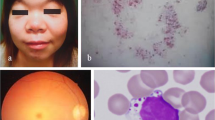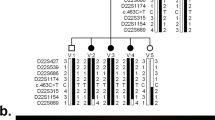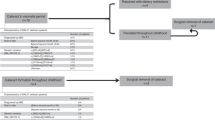Abstract
Galactokinase is an essential enzyme for the metabolism of galactose and its deficiency causes congenital cataracts during infancy and presenile cataracts in the adult population. We have cloned the human galactokinase cDNA, which maps to chromosome 17q24, and show that the isolated cDNA expresses galactokinase activity in bacteria and mammalian cells. We also describe two different mutations in this gene in unrelated families with galactokinase deficiency and cataracts. The availably of the cloned galactokinase gene provides an important reference to identify mutations in patients with galactokinase deficiency and cataracts.
This is a preview of subscription content, access via your institution
Access options
Subscribe to this journal
Receive 12 print issues and online access
$209.00 per year
only $17.42 per issue
Buy this article
- Purchase on Springer Link
- Instant access to full article PDF
Prices may be subject to local taxes which are calculated during checkout
Similar content being viewed by others
References
Foster, A. & Johnson, G.J. Magnitude and causes of blindness in the developing world. Int. Ophthalmol. 14, 135–140 (1990).
Segal, S. Disorders of Galactose Metabolism. in The Metabolic Basis of Inherited Disease. Vol. 1. (eds Scriver, C.R. et al.) 453–480 (McGraw-Hill, New York, 1989).
Gitzelmann, R. Deficiency of erythrocyte galactokinase in a patient with galactose diabetes. Lancet 2, 670–671 (1965).
Stambolian, D. Galactose and cataract. Survey of Ophthalmol. 32, 333–349 (1988).
Tedesco, T.A. et al. The Philadelphia variant of galactokinase. Am. J. hum. Genet. 29, 240–247 (1977).
Magnani, M., Cucchiarini, L., Dacha, M & Fornaini, G. A new variant of galactokinase. Hum. Hered. 32, 329–334 (1982).
Tedesco, T.A. et al. A variant of human galactokinase with elevated activity. Pediatr. Res. 7, 394 (1973).
Tedesco, T.A. et al. Human erythrocyte galactokinase and galactose-1-phosphate uridylyltransferase: a population survey. Am. J. hum. Genet. 27, 737–747 (1975).
Segal, S., Rutman, J.Y. & Frimpter, G.W. Galactokinase deficiency and mental retardation. J. Pediatr. 95, 750–752 (1979).
Stambolian, D., Scarpino-Myers, V., Eagle, R.C., Hodes, B. & Harris, H. Cataracts in patients heterozygous for galactokinase deficiency. Invest. Ophthal. Vis. Sci. 27, 429–433 (1986).
Skalka, H.W. & Prchal, J.T. Presenile cataract formation and decreased activity of galactosemic enzymes. Arch. Ophthalmol. 98, 269–273 (1980).
Monteleone, J.A., Beutler, E., Monteleone, P.L., Utz, C.L. & Casey, E.C. Cataracts, galactosuria, and hypergalactosemia due to galactokinase deficiency in a child. Studies of a kindred. Am. J. Med. 50, 403–407 (1971).
Levy, N.S., Krill, A.E. & Beutler, E. Galactokinase deficiency and cataracts. Am. J. Ophthalmol. 74, 41–48 (1972).
Magnani, M., Cucchiarini, L., Stocchi, V. & Dacha, M. Red blood cell galactokinase activity and presenile cataracts. Enzyme 29, 58–60 (1983).
Harley, J.D., Irvine, S., Mutton, P. & Gupta, J.D. Maternal enzymes of galactose metabolism and the inexplicable ingantile cataract. Lancet 2, 259–261 (1974).
Debouck, C. et al. Structure of the galactokinase gene of E. coli, the last (?) gene of the gal operon. Nucl. Acids Res. 13, 1841–1853 (1985).
Citron, B.A. & Donelson, J.E. Sequence of the Saccharomyces GAL region and its transcription in vivo. J. Bact. 158, 269–278 (1984).
Adams, C.W., Fornwald, J.A., Schmidt, F.J., Rosenberg, M. & Brawner, M.E. Gene organization and structure of the Streptomyces lividans gal operon. J. Bact. 170, 203–212 (1988).
Lee, R.T., Peterson, C.L., Calman, A.F., Herskowitz, I. & O'Donnell, J.J. Cloning of a human galactokinase gene (GK2) on chromosome 15 by complementation in yeast. Proc. natn. Acad. Sci. U.S.A. 89, 10887–10891 (1992).
Elsevier, S.M. et al. Assignment of the gene for galactokinase to human chromosome 17 and its regional localization to band q21–22. Nature 251, 633–636 (1974).
Stambolian, D., Scarpino-Myers, V. & Harris, H. Purification of human galactokinase and evidence for its existence as a monomer form. Biochim. Biophys. Acta. 831, 306–312 (1985).
Adams, M.D. et al. Complementary DNA sequencing: expressed sequence tags and human genome project. Science 252, 1651–1656 (1991).
Tsay, Y.H. & Robinson, G.W. Cloning and characterization of ERGS, an essential gene of Saccharomyces cerevisiae that encodes phosphomevalonate kinase. Molec. cell. Biol. 11, 620–631 (1991).
McKenney, K. et al. A system to study promoter and terminator signals recognized by E.coli RNA polymerase. In Gene Amplification and Analysis. Vol. II(eds Chirikjian, J.G. & Papas, T.) 383–415 (Elsevier-North Holland, 1981).
Aijar, N. et al. Human AT1 receptor is a single copy gene:characterization in a stable cell line. Molec. cell. Biochem. 131, 75–86 (1994).
Pickering, W.R. & Howell, R.R. Galactokinase deficiency: clinical and biochemical findings in a new kindred. J. Peds. 81, 50–55 (1972).
Olambiwonnu, N.O., McVie, R., Ng, W.G., Frasier, S.D. & Donnell, G.N. Galactokinase deficiency in twins: clinical and biochemical studies. Pediatrics 53, 314–318 (1974).
Best, S., Reim, D.F., Mozdzanowski, J. & Speicher, D.W. High sensitivity peptide sequence analysis using In Situ proteolysis on high retention PVDF membranes and a biphasic reaction column sequencer. in Techniques in Protein Chemistry V (ed. Crabb, J.W.) 205–213 (Academic Press, New York, 1994
Gluzman, Y. SV40-transformed simian cell support the replication of early SV40 mutants. Cell 23, 175–182 (1981).
Caltabiano, M.M. et al. Transient production and secretion of human transforming growth factor TGF-b2. Gene 85, 479–488 (1989).
Stambolian, D., Scarpino-Myers, V. & Harris, H. Isoelectric focusing of galactokinase in lens and other tissues. Exp. Eye Res. 38, 231–237 (1984).
Stephenson, C. et al. Normal expression of thymidine kinase and O6-Methylguanine-DNA Methyltransferase in cultured fibroblasts from individuals with hereditary galactokinase deficiency. Biochem. Genet. 29, 135–144 (1991).
Sambrook, J., Frirsch, E.F. & Maniatis, T., Cloning: a laboratory manual. (Cold Spring Harbor, Cold Spring Harbor, 1989).
Proudfoot, N.J. & Brownlee, G.G. 3′ Non-coding region sequences in eukaryotic mRNA. Nature 263, 211 (1976).
Mollet, B. & Pilloud, N. Galactose utilization in Lactobaciilus helveticus:isolation and characterization of the galactokinase (galK) and galactose-1 -phosphate uridyl transferase (gall) genes. J. Bacteriol. 173, 4464–4473 (1991).
Meyer, J., Walker-Jonah, A. & Hollenberg, C.P. Galctokinase encoded by GAL1 is a bifunctional protein required for induction of the GAL genes in Kluyveromyces lactis and is able to suppress the gal3 phenotype in Saccharomyces cerevisiae. Molec. cell. Biol. 11, 5454–5461 (1991).
Author information
Authors and Affiliations
Rights and permissions
About this article
Cite this article
Stambolian, D., Ai, Y., Sidjanin, D. et al. Cloning of the galactokinase cDNA and identification of mutations in two families with cataracts. Nat Genet 10, 307–312 (1995). https://doi.org/10.1038/ng0795-307
Received:
Accepted:
Issue Date:
DOI: https://doi.org/10.1038/ng0795-307
This article is cited by
-
Unraveling the genetic cause of hereditary ophthalmic disorders in Arab societies from Israel and the Palestinian Authority
European Journal of Human Genetics (2020)
-
Genetic landscape of isolated pediatric cataracts: extreme heterogeneity and variable inheritance patterns within genes
Human Genetics (2019)
-
Educational paper
European Journal of Pediatrics (2012)
-
N-acetylgalactosamine Kinase: A Naturally Promiscuous Small Molecule Kinase
Applied Biochemistry and Biotechnology (2012)
-
Features and outcome of galactokinase deficiency in children diagnosed by newborn screening
Journal of Inherited Metabolic Disease (2011)



